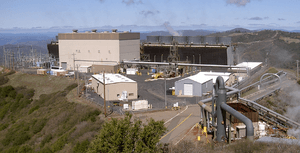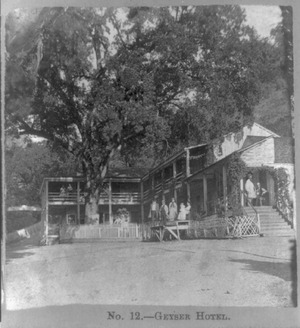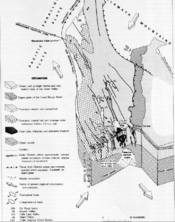The Geysers facts for kids
Quick facts for kids The Geysers |
|
|---|---|

The Sonoma Calpine 3 power plant is one of 18 power plants at The Geysers
|
|
| Country | United States |
| Location | Sonoma and Lake counties California |
| Coordinates | 38°47′26″N 122°45′21″W / 38.79056°N 122.75583°W |
| Status | Operational |
| Commission date | September 1960 |
| Owner(s) | Calpine Corporation (86.5%) NCPA (4.5%) Silicon Valley Power (4.5%) USRG (4.5%) |
| Operator(s) | Calpine Corporation |
The Geysers is the biggest geothermal field in the world. It has 18 geothermal power plants. These plants get steam from over 350 wells. The Geysers is located in the Mayacamas Mountains in California. It is about 72 miles (116 km) north of San Francisco.
In 2019, The Geysers created about 20% of California's renewable energy.
Contents
History of The Geysers
For about 12,000 years, Native American tribes used the Geysers area. They built steambaths and warm pools. They used the steam and hot water for healing. They also used it for spiritual ceremonies and cooking. The warm pools helped with pain like rheumatism and arthritis. Heated muds from the fumaroles (steam vents) soothed skin problems.
When Europeans first arrived, six Native American tribes lived near the Geysers. These included three groups of Pomo people, two groups of Wappo people, and the Lake Miwok people. The Wappo also collected sulfur from the area. Today, Calpine Corporation makes electricity here. They are a large producer of power from natural gas and geothermal sources in the US.
First European Discovery
In 1847, William Bell Elliot saw The Geysers. He was part of John C. Frémont's survey of the Sierra Nevada mountains. Elliot named the area "The Geysers." But the hot spots he found were not true geysers. They were actually fumaroles, which are vents that release steam and gases.
The Geysers Resort Hotel
From 1848 to 1854, Archibald C. Godwin built a spa called The Geysers Resort Hotel. Many tourists visited, including famous people like Ulysses S. Grant, Theodore Roosevelt, and Mark Twain. The resort became less popular in the mid-1880s. It then tried to attract people with less money.
In 1938, a landslide destroyed the main building. But the restaurant, small cabins, and swimming pool stayed open. They even stayed open after a fire in 1957, until about 1979. In 1960, Pacific Gas and Electric Company (PG&E) started a geothermal power plant there. It made 11 megawatts of electricity. In 1980, Unocal Corporation took down what was left of the resort.
Fires at The Geysers
The Valley Fire in September 2015 damaged five of the Geysers' facilities. Their cooling towers were badly hurt. However, the main power buildings were not damaged.
The Kincade Fire started near The Geysers on October 23, 2019. It began during very strong winds. The fire burned 77,758 acres (31,468 ha) before it was stopped on November 6.
Historical Landmark
In 1976, the Geysers Geothermal Power Development project was named a California Historic Civil Engineering Landmark. This was done by the San Francisco Section of the American Society of Civil Engineers.
How Geothermal Power Works
The Geysers is the world's largest geothermal field. It covers about 30 square miles (78 km2). It is in Sonoma, Lake, and Mendocino counties in California. The power from The Geysers provides electricity to many nearby counties. It is thought to meet 60% of the power needs for the coastal area between the Golden Gate Bridge and the Oregon border.
Most geothermal areas produce hot water. But The Geysers is different. It is a "dry steam field." This means it mainly produces very hot, dry steam.
Steam Source
The steam used at The Geysers comes from a rock layer called greywacke sandstone. This layer is covered by rocks that don't let much water through. Below it is a silicic rock formation. Scientists believe the heat for the steam comes from a large magma chamber. This magma chamber is over 4 miles (6 km) deep and more than 8 miles (13 km) wide.
The first geothermal wells drilled in Geyser Canyon were the first in the Western Hemisphere. The first power plant at The Geysers opened in 1921. It was built by the owner of The Geysers Resort. It made 250 kilowatts of power to light the resort. In 1960, Pacific Gas and Electric Company (PG&E) started their 11-megawatt plant. Its original turbine worked for over 30 years.
Recharging the Steam Field
By 1999, the amount of steam at The Geysers started to decrease. This meant less power could be made. However, since 1997, the steam field has been refilled. This is done by injecting treated wastewater into the ground. This process added about 77 megawatts of power in 2004.
The treated water travels up to 50 miles (80 km) through pipes. It comes from wastewater treatment plants in Lake County. In 2003, the City of Santa Rosa and Calpine Corporation built a 42-mile pipeline. This is called the Santa Rosa Geysers Recharge Project (SRGRP). Since 2003, this project has sent about 11 million gallons of treated wastewater each day. This water helps to refill The Geysers' geothermal reservoir.
Injecting this treated water helps in two ways. First, it protects local rivers and Clear Lake. The wastewater used to go into these surface waters. Second, it helps produce electricity without releasing greenhouse gases into the air.
Geothermal Power Stations
There are many geothermal power stations at The Geysers. Calpine owns 19 of them. They bought most of these from PG&E and Unocal Geothermal in 1999. Other companies like Northern California Power Agency (NCPA) and Silicon Valley Power also own parts of the plants. Bottle Rock is owned by Bottle Rock Power LLC.
Ormat also has plans for a new 30 MW geothermal power station. It will be built at the old Calpine 15 site.
| Name | Unit | Type | Status | Capacity (MWel) |
Commissioned | Decommissioned |
|---|---|---|---|---|---|---|
| Bottle Rock | BRP | Dry steam | Operational | 55 | March 1985 October 2007 |
|
| Aidlin | Calpine 1 | Dry steam | Operational | 20 | May 1989 | |
| Bear Canyon | Calpine 2 | Dry steam | Operational | 20 | September 1988 | |
| Sonoma | Calpine 3 | Dry steam | Operational | 78 | December 1983 | |
| West Ford Flat | Calpine 4 | Dry steam | Operational | 27 | December 1988 | |
| McCabe | Calpine 5 | Dry steam | Operational | 55 | April 1971 | |
| Calpine 6 | Dry steam | Operational | 55 | April 1971 | ||
| Ridge Line | Calpine 7 | Dry steam | Operational | 55 | July 1972 | |
| Calpine 8 | Dry steam | Operational | 55 | July 1972 | ||
| Fumarole | Calpine 9 | Dry steam | Offline since 2001 | 55 | November 1973 | |
| Calpine 10 | Dry steam | Offline since 2000 | 55 | November 1973 | ||
| Eagle Rock | Calpine 11 | Dry steam | Operational | 110 | December 1975 | |
| Cobb Creek | Calpine 12 | Dry steam | Operational | 110 | August 1979 | |
| Big Geysers | Calpine 13 | Dry steam | Operational | 60 | April 1980 | |
| Sulfur Springs | Calpine 14 | Dry steam | Operational | 114 | February 1980 | |
| PG&E 15 | Calpine 15 | Dry steam | Decommissioned | 62 | June 1979 | 1997 (Dismantled) |
| Quicksilver | Calpine 16 | Dry steam | Operational | 119 | October 1985 | |
| Lake View | Calpine 17 | Dry steam | Operational | 119 | November 1982 | |
| Socrates | Calpine 18 | Dry steam | Operational | 119 | November 1983 | |
| Calistoga | Calpine 19 | Dry steam | Operational | 80 | March 1984 | |
| Grant | Calpine 20 | Dry steam | Operational | 119 | October 1985 | |
| Buckeye | Calpine | Dry steam | Planned | ? | TBD | |
| Wild Horse | Calpine | Dry steam | Planned | ? | TBD | |
| Coldwater Creek | CCPA 1 | Dry steam | Decommissioned | 65 | May 1988 | 2000 (Dismantled) |
| CCPA 2 | Dry steam | Decommissioned | 65 | October 1988 | 2000 (Dismantled) | |
| NCPA 1 & 2 | NCPA 1 | Dry steam | Operational | 55 | February 1983 | |
| NCPA 2 | Dry steam | Operational | 55 | February 1983 | ||
| NCPA 3 & 4 | NCPA 3 | Dry steam | Operational | 55 | November 1985 | |
| NCPA 4 | Dry steam | Operational | 55 | November 1985 | ||
| TBD | Ormat | Dry steam | Planned | 30 | TBD | |
| PG&E 1 & 2 | PG&E 1 | Dry steam | Decommissioned | 12 | September 1960 | 1993 (Dismantled) |
| PG&E 2 | Dry steam | Decommissioned | 14 | September 1960 | 1993 (Dismantled) | |
| PG&E 3 & 4 | PG&E 3 | Dry steam | Decommissioned | 28 | March 1963 | 1995 (Dismantled) |
| PG&E 4 | Dry steam | Decommissioned | 28 | March 1963 | 1995 (Dismantled) |
Earthquakes at The Geysers
Small earthquakes (less than 2.0 magnitude) happen often in the area. About 99% of all earthquakes at The Geysers are 3.0 magnitude or smaller. The number of earthquakes larger than 3.0 has actually gone down since 1990. Because the area is far from cities, people rarely feel these small shakes.
Scientists use special tools called seismometers to measure these tiny earthquakes. Studies show that injecting water into the ground to make geothermal electricity causes these quakes.
Before 1969, there were almost no earthquakes above magnitude 2 recorded near The Geysers. This might be because there weren't many tools to detect them back then. Studies show that injecting water causes earthquakes from magnitude 0.5 to 3.0. A 4.6 magnitude quake happened in 1973. Even with more water being injected, the number of magnitude 3 earthquakes has stayed about the same since the 1980s. However, the total number of all earthquakes has increased a lot.
A 4.5 magnitude earthquake hit near The Geysers on January 12, 2014. A 5.0 magnitude quake happened on December 14, 2016. On March 3, 2022, a 3.8 magnitude earthquake occurred directly under the field. Even with these quakes, a very large earthquake is unlikely at The Geysers. This is because there isn't a major fault nearby.
Air Quality and Geochemistry
In 2005, special equipment was put in two of the Geysers plants. This equipment helps to reduce the amount of mercury released into the air. Even before this, the amount of mercury was below the legal limit. The Geysers Air Monitoring Programs (GAMP) have also shown very small amounts of arsenic released. These amounts are also below safe levels.
Electricity Production
The power plants at The Geysers are "dry steam" type plants. This means the steam directly spins the generators to make electricity. The Geysers has about 1517 MW of power capacity. On average, it produces about 955 MW of electricity.
In 2014, there were almost two dozen active plants at The Geysers. Calpine Corporation ran 19 plants in 2004, but only 15 in 2013. Two other plants are owned by the Northern California Power Agency and the City of Santa Clara.
Geology of The Geysers
The Geysers is located on the northeast side of the Mayacamas anticline. This is a fold in the Earth's rock layers. It is bordered by the Collayomi Fault to the northeast and the Mercuryville Fault to the southwest. The main rock that holds the steam is a type of sandstone called graywacke. This rock is broken and fractured.
Scientists have studied the area using gravity and seismic waves. They found a large magma body under the Clear Lake Volcanic Field. This magma body is likely what heats the geothermal area.
See also
 In Spanish: The Geysers para niños
In Spanish: The Geysers para niños
- List of geothermal power stations in the United States
- List of power stations in California





